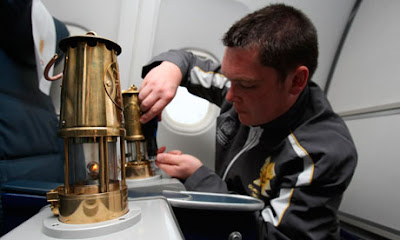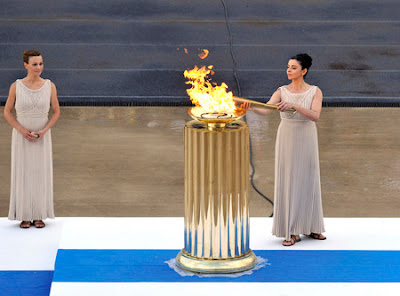In the ancient Greek religion, Zeus is the "Father of gods and men" who rules the Olympians of Mount Olympus as a father rules the family. He is the god of sky and thunder in Greek mythology. His Roman counterpart is Jupiter and Etruscan counterpart is Tinia. His Hindu equivalent is Indra.
Zeus is the child of Cronus and Rhea, and the youngest of his siblings. In most traditions he is married to Hera, although, at the oracle of Dodona, his consort is Dione: according to the Iliad, he is the father of Aphrodite by Dione. He is known for his erotic escapades.
In Olympia (Greece), a flame was ignited by the sun and then kept burning until the closing of the Olympic Games. The fire was reintroduced at the 1928 Summer Olympics in Amsterdam, it has been part of the modern Olympic Games ever since. In contrast to the Olympic flame proper, the torch relay of modern times which transports the flame from Greece to the various designated sites of the games was not observed in ancient Olympic games and was introduced by Carl Diem at the 1936 Summer Olympics in Berlin.
The idea of keeping a flame burning throughout the Games was first used by the ancient Greeks in Olympia.
She uses a parabolic mirror to focus light rays from the sun. The parabolic mirror has a curved shape. When it is held toward the sun, the curvature focuses the rays to a single point. The energy from the sun creates a great deal of heat. The priestess holds a torch in the center of the parabolic mirror, and the heat ignites the fuel in the torch, sparking a flame.
If the sun is not shining on the day of the lighting ceremony, the priestess can light the torch with a flame that was lit on a sunny day before the ceremony.
CEREMONY TO LIGHT THE OLYMPIC TORCH FOR THE LONDON 2012 OLYMPICS
The flame is carried in a fire pot to an altar in the ancient Olympic stadium, where it is used to light the first runner's torch.
For the Winter Games, the relay actually begins at the monument to Pierre de Coubertin (the man who founded the modern Olympic games in 1896), which is located near the stadium.
When the first torch is lit, the relay begins.
.jpg) The flame is carried by relay all the way to its final destination. Although it is usually carried by runners on foot, other modes of transportation are also used. For air transportation, the flame is sheltered in a security lamp, similar to a miner's lamp. At night, the flame is kept in a special cauldron.
The flame is carried by relay all the way to its final destination. Although it is usually carried by runners on foot, other modes of transportation are also used. For air transportation, the flame is sheltered in a security lamp, similar to a miner's lamp. At night, the flame is kept in a special cauldron.The highlight of the opening ceremony of the Olympics is the entrance of the Olympic flame into the stadium. The final torchbearer is always a citizen of the host country whose identity is kept secret until the last moment.
The final torchbearer does a lap around the stadium before lighting the huge cauldron with the Olympic flame. Pigeons are then released as a symbol of the peace in which the Olympic Games should take place.
The flame remains lit for the duration of the Games.
The Olympic flame was lit in Ancient Olympia in Greece on May 10 2012, in a solemn ceremony filled with mystery and tradition that signals the final countdown to the start of this year's summer Games in London.
Actors in ancient Greek costume INVOKED the god Apollo in the ruins of the 2,600-year-old Temple of Hera, using a concave mirror to harness the sun's rays and kindle a flame on the torch for a relay that will take it around Greece and Britain.
Dignitaries at the ceremony included the president of the International Olympic Committee Jacques Rogge, as well as the head of the London organising committee, Sebastian Coe.
"We promise to protect the flame, to cherish its traditions and stage an uplifting torch relay of which we can be proud," Coe said in a speech, vowing the event would "lift the spirits and hopes of people across Britain and across the world".
Accoding to the UK GUARDIAN It was a majestic moment. The clouds came and then they went and in between the sun popped out. In that moment Ino Menegaki, the highest of "high priestesses", gathered before the great stone alter of the temple of Hera, took her torch, placed it in a parabolic mirror and lit it from the sun's rays. In a second, it seemed, the Olympic flame was born. The journey to the London 2012 Games had begun.
Only Dignitries were allowed into the sanctuary, the most sacred part of this most sacred place, there was hushed silence during the lighting of the flame, as a white dove flew into the skies, the women among them wept.
The symbol of fellowship and harmony aglow, the search began for an olive branch – the symbol of peace and a vital part of this great ancient ritual. And, when that was found, the high drama continued as the priestesses made their way out of the sanctuary, their cream robes flowing in the breeze that for a moment appeared to extinguish the flame, before Menegaki, an actress who has been performing the ceremony for years, relit the torch from one of the many backups the organisers ensure are always there.
Then the priestesses came over the mound, some dancing, some walking, before those in the stadium – around 2,000 Britons, Greeks and an assortment of tourists – erupted into rapturous applause.
There were men among them also attired in ancient garb. And as they danced and the women gyrated – in honour of Apollo the god of light – Spyros Gianniotis, the British-born Greek 10km swimming world champion, given the privilege of being the first torch-bearer, waited below.
The flame was the great connector "between the ancient Games and the modern Games, cities, towns and villages across Greece and Britain."
After 5,000 years the Greeks are good at this sort of thing. And, after the first modern Olympic flame lighting ceremony (held at Hitler's request for the 1936 Berlin Games) they have gotten better.
But then, nothing evokes Greece's historic, or even mystic, sense of mission more than ancient Olympia, the birthplace of the Games – even in the midst of its worst crisis since the second world war.

For it was here in the verdant valleys and foothills of a remote corner of the Peloponnese that the Gods first wrestled and men – laying down their arms for "a sacred month" in a land riven by disputes and divided by war – subsequently wrestled and learned to be heroes too.
The Olympic symbol travelled almost 2,000 miles through Greece before it was officially handed to the London organising committee in Athens and flown, in its own seat in a custom-made box, on a British Airways plane on 17 May. From the Royal Navy airbase at Culdrose, Cornwall, where it lands, it begins a 70-day, 8,000-mile torch relay across Britain before reaching the Olympic Stadium in Stratford, east London, on the evening of 27 July for the opening ceremony of the Games.
 |
| the olympic torch in flight |
"It was a unique moment," said Gianniotis, who ran through the stadium with torch and olive branch in hand followed by a cameraman on wheels. "It is an honour to compete in an Olympic Games but it is an even bigger honour to carry the flame."
 |
| the DUKE and DUCHESS OF CAMBRIDGE , PRINCE HARRY are all smiles as they meet torchbearers Wai-Ming Lee and John Hulse in Buckingham Palace |
 |
| David Beckham bringing the olympic torch in style to the stadium |
 |
| I cant forget this smile..reminds me of JAMES BOND |
 |
| THE TORCH COMES ALIVE |
and the comic relief...lol
 |
| MR BEAN...LOLOLOLOLZZZZ |
Each of the 8,000 torchbearers ran about 300 metres with the flame. In Greece, where it crossed mountains and rivers and seas, passing through 40 towns and 26 prefectures, 38 municipalities and five archaeological sites.
OLYMPIC TORCH LINE
1936
 |
1948
The torch for the London Games was designed by Ralph Laver and was said to be inspired by the torches of ancient Greece and Rome, with a chalice-shaped top
1952
The Helsinki Olympics torch was of a conical shape, on the bottom part of the burner is the inscription "XV Olympia Helsinki 1952" and on the rings underneath "Helsinki Helsingfors". Helsingfors is the original name of the city of Helsinki. The handle was made of lacquered wood..
1956
This torch had a very similar design to the torch of the 1948 London Games. On the base of the chalice-shaped top was the Olympic rings and inscription "XVI Olympiad Melbourne 1956".
1960
This torch was based on a classic model, inspired by the torches reproduced on ancient monuments. On the base there is an inscription: "Giocchi della XVII Olympiade", meaning "Games of the 17th Olympiad".
1964
The torch for the 1964 Olympics was made of a cylindrical tube covered in stainless steel and filed with gunpowder and smoke. The support was designed to go with the torch and was made of lightweight aluminium. The inscription "XVIII Olympiad Tokyo 1964" is inscribed alongside the Olympic rings.
1968
The Mexico City torch design recreates the "Mexico 68" logo that is featured on the emblem and posters. The torch is cone-shaped, grooved and carved, and bears the inscription "MEXICO 68" around the rim at the top
1972
A torch design like that used in 1962. On the combustion tube is inscribed "Spiele der XX Olympiade München 1972" (in German "Games of the 20th Olympiad Munich 1972"). On the handle are the Olympic rings and the emblem of the Games - a crown of rays of light.
1976
The torch designers for the Montreal Games chose a functional design made from lightweight aluminium, to assist each runner who had to run one kilometer holding the torch. The black top part was chosen with the aim of making the flame more visible in photographs
1980
Soviet engineers broke from tradition for their revolutionary torch for the Russian Games. In reference to Cold War tensions of the time the design incorporated a small red star..
1984
The leather handle features a metallic ring and the caption "Games of the XXIII Olympiad Los Angeles 1984" with the Olympic motto "Citius Altius Fortius" and the picture of the Memorial Coliseum. The right to be part of the torch relay in Los Angeles 1984 was sold for $3,000 a kilometer, over Greek protests, although the $11 million raised went to local youth groups
1988
The torch for the 1988 Seoul Olympics had a leather handle. At the top of the leather handle is the caption: "Games of the XXIVth Olympiad Seoul 1988", and the emblem together with a Korean drawing..
1992
1996
The torch for the Atlanta Games was the tallest of all Olympic torches so far, and the only one designed to be grasped in the middle. The torch was modelled on a cluster of reeds bound with twine.
2000
his torch was inspired by the architecture of the Sydney Opera House, the blue waters of the Pacific Ocean and the subtle curve of the boomerang. The torches three layers are representative of earth, fire and water.
2004
The Athens torch was inspired by an olive tree leaf. The design was selected to enhance the flame with its upward dynamic shape. Its ergonomic curved design establishes the torch as the continuation of the flame, which which in turn rises as a continuation of the torchbearer's hand. The torch weighed 700 grams and was 68 cm long, and made of metal (magnesium) and wood (olive tree).
2008
The red curved torch was inspired by the shape of a traditional Chinese scroll. It was inscribed with swirling graphics designed to evoke the phoenix, a key totem of the games, and 'clouds of promise'. The torch relay was not without controversy, with the journey to Beijing disrupted by protestors against the Chinese occupation of Tibet
2012
The torch for the 2012 London Olympics was designed by Edward Barber and Jay Osgerby. The 800mm long gold colored torch is made from hi-tech aluminum casing covered in a mesh of 8,000 holes – one for each runner and mile covered during the relay. The torch is triangular, reflecting the three times that London has hosted the Games (1908, 1948 and 2012) as well as representing the Olympic values of respect, excellence and friendship
WATCH THE OLYMPIC TORCH LIGHTING CEREMONY @ GREECE
REFERENCES
http://english.sina.com/sports/2012/0510/466542.html
http://www.guardian.co.uk/sport/2012/may/10/london-2012-olympic-torch-begins-journey-olympia
Onenigerianboy.blogspot.com
http://en.wikipedia.org/wiki/Olympic_Flame.







.jpg)
.jpg)










.jpg)


No comments:
Post a Comment
Please leave a comment!